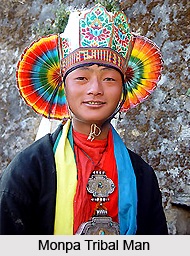 People of Tawang District mainly constitute the Monpas, who are believed to be of a Mongoloid descent and immigrants from Tibet and Bhutan. However, the circumstances which resulted in the migration of the Monpas is veiled in mystery. A Tibetan epic named `Dowa Sangmo`, which is as old as the 7th century has mentioned a region called `Tana Mandegang`, which is said to be the kingdom which was ruled by the king Kala Wangpo.
There exists a popular legend which asserts that Acharya Padmasambhava, an Indian saint had paid a visit to this place in the 8th century.
People of Tawang District mainly constitute the Monpas, who are believed to be of a Mongoloid descent and immigrants from Tibet and Bhutan. However, the circumstances which resulted in the migration of the Monpas is veiled in mystery. A Tibetan epic named `Dowa Sangmo`, which is as old as the 7th century has mentioned a region called `Tana Mandegang`, which is said to be the kingdom which was ruled by the king Kala Wangpo.
There exists a popular legend which asserts that Acharya Padmasambhava, an Indian saint had paid a visit to this place in the 8th century.
The Monpa tribes follow Buddhism and the Tawang Monastery located here is a significant centre of their religious life. Prior to embracing Buddhism, the Monpas practised spirit worship as well as the sacrifice of wild animals. Motivated by the principles laid down by Lord Buddha, the Monpas are generally courteous and compassionate. The major occupation of these people is industrial, trade and cattle breeding. They are also known to breed yaks.
Monpas perform terraced cultivation processes and produce crops like tomatoes. It is said that the cultivation of potatoes commenced in the Tawang District in the 1970`s era, when the `Kufri Jyoti` species of potatoes were quite popular in this area. The local farmers had brought the seeds of potatoes from the North- Indian state of Himachal Pradesh and used to sell these seeds to the farmers belonging to Arunachal Pradesh. Several varieties of horticulture crops like almonds, walnuts, oranges and apples are cultivated by the people of Tawang district. Monpas reside in comfortable double-storied homes which are manufactured from stone and decorated with carved doors, window frames and plank floors. The inhabitants of this Indian district are quite artistic and are known to create excellent artefacts like bamboo utensils, carpets, wood carvings and many other items. `Thangka` paintings and hand-made paper crafts manufactured by the people of Tawang district have earned recognition. While monogamy is the general rule followed by the residents of Tawang, polyandrous marriages are also common in this portion of the country. Numerous people dwelling here are also known to follow the process of marriage though negotiation.



















